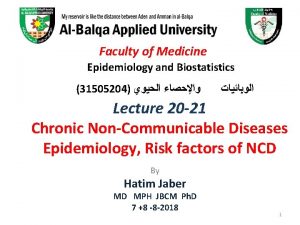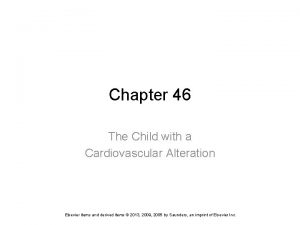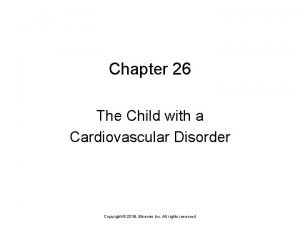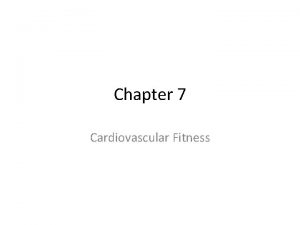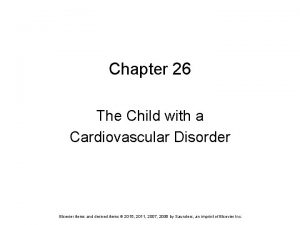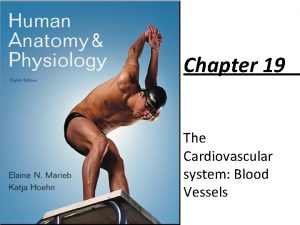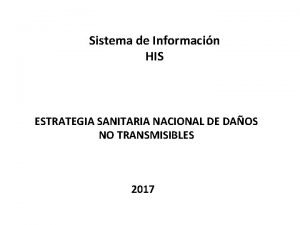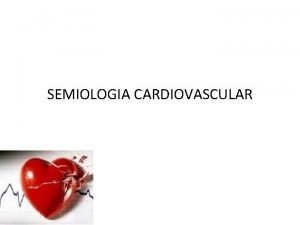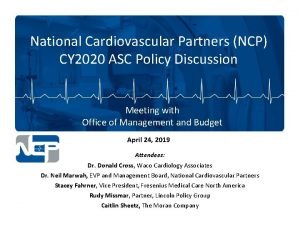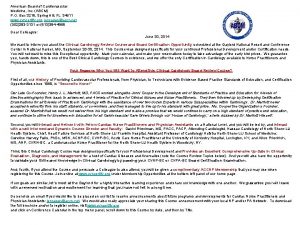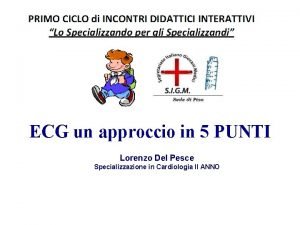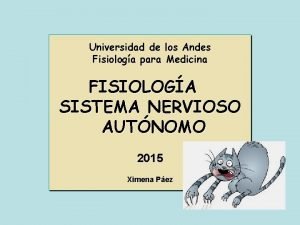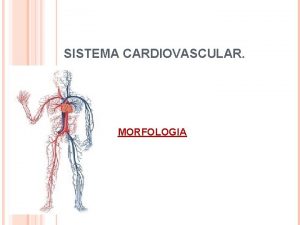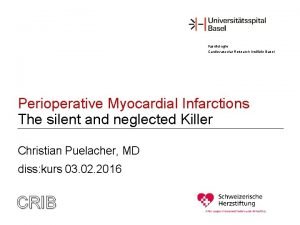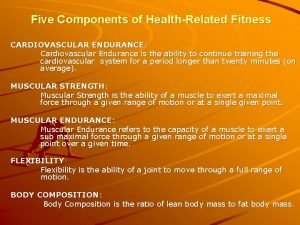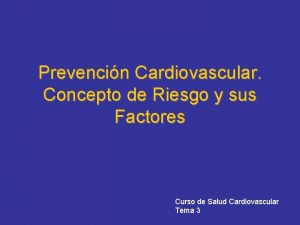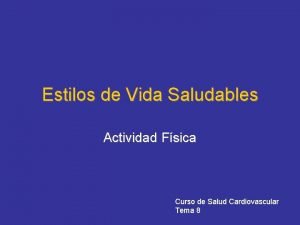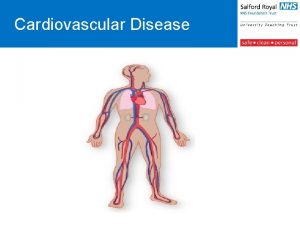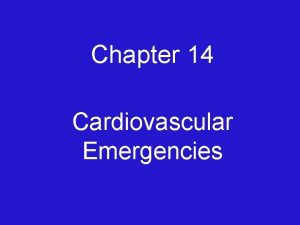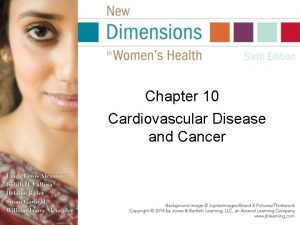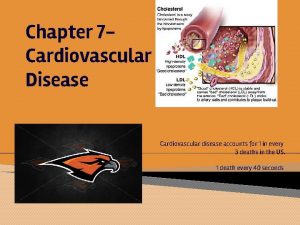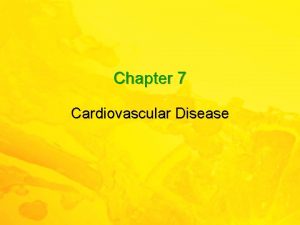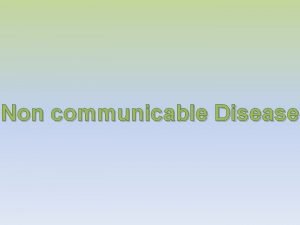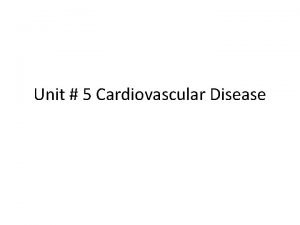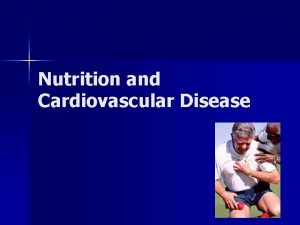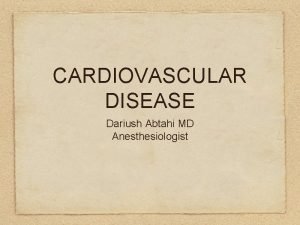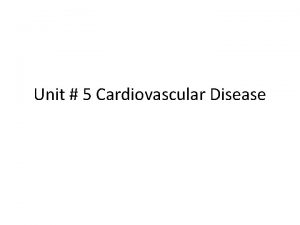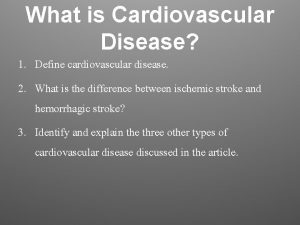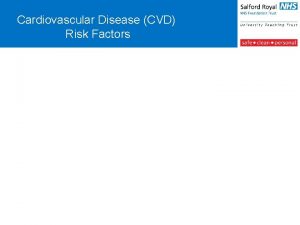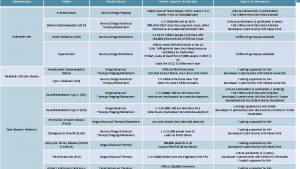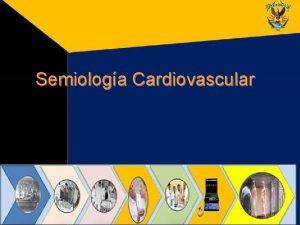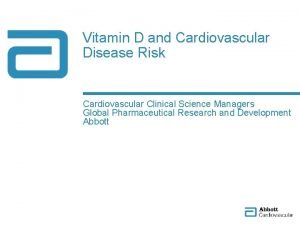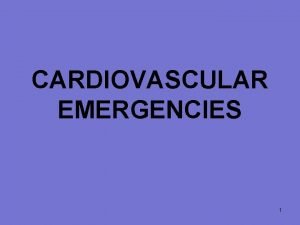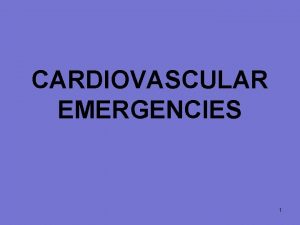Cardiovascular Disease Chapter 15 1 Introduction Cardiovascular disease








































- Slides: 40

Cardiovascular Disease Chapter 15 1

Introduction • Cardiovascular disease (CVD) is the leading cause of death in the U. S. • One American dies from CVD every 33 seconds • Nearly half of all Americans will die from CVD • CVD is the leading cause of death for both men and women • 45% of all heart attacks occur in people under the age of 65 • Most of CVD risk is lifestyle-related 2

The Cardiovascular System Pulmonary circulation Blood to and from the lungs. Systemic circulation Left side of the heart pumps blood through the rest of the body. 3

4

5

Cardiovascular System Heart, blood vessels, hormones, enzymes and wastes. Four chambers (size of a fist). Upper chambers (Atriums). Lower chambers (Ventricles). Vena cava Pulmonary Artery and Vein. Aorta. Coronary Arteries. 6

7

Cardiovascular System Systole and Diastole. action of the heart is controlled by an electrical signal which originates in the right atrium. Veins carry blood back to the heart. Arteries carry blood away from the heart. Capillaries 8

Risk Factors Major Risk factors Contributing Risk Factors Six Major Risk Factors that can be changed. Tobacco use. Physical inactivity. Obesity High blood pressure. Diabetes High levels of cholesterol. LDL’s and HDL’s 9

Tobacco Use Smokers have 2 -3 times higher risk of heart attack Reduces HDL’s CO displaces O 2 Causes platelets to become sticky and increases blood thickness 10

High Blood Pressure Too much pressure against arterial walls Heart has to work harder, weakens, enlarges, arteries scar and harden 11

High Blood Pressure Tachycardias. 100 or more beats per minute. Compromises the ability of the heart to pump effectively. Ventricles can not completely fill. 12

Low Blood Pressure Bradychardia 60 or less beats per minute Poor circulation of the blood Lack of 02 throughout to body and brain 13

Cholesterol Clogs the arteries Increased risk of CVD LDL’s - less than 120 dl/mg HDL’s - greater than 60 dl/mg Total cholesterol should be below 200 dl/mg Levels over 240 indicates high risk of CVD 14

15

Physical Inactivity Exercise reduces risk by: Lowering LDL’s Controlling Blood pressure Increasing HDL’s Maintaining weight Helps prevent or controls Diabetes 16

Other Contributing Factors Obesity More than 30% above recommended weight. Increase strain on the heart. Diabetes Having doubles the risk of CVD. 17

Body Weight More than 30% High cholesterol levels High blood pressure Excessive strain on the heart Fat collected in the torso more dangerous 18

Contributing Risk Factors That Can Be Changed High Triglyceride Levels Psychological factors Chronic hostility and anger Suppressing psychological disorders Depression and anxiety Social factors Social isolation Low socioeconomic status 19

Elevated Triglycerides Combines with LDL’s Causes lowered HDL’s Linked with Obesity Linked with Diabetes Reliable predictor of CVD Best means of Reduction: Exercise weight loss, and dietary changes 20

Factors Not Controllable Heredity - CVD has genetic component; high cholesterol levels, blood clotting and obesity Age - Over the age of 65 Sex - Men have higher risk earlier in life Ethnicity - African Americans have higher risk of hypertension; Hispanics greater risk of HBP and Angina; Asians Lower rates of CVD 21

Possible Risk Factors Currently Being Studied Homocysteine Lipoprotein(a) LDL Particle size. Infectious agents Inflammation and C-Reactive Protein Fibriongen Blood Viscosity and Iron Uric Acid Syndrome X 22

23

Major Forms of Cardiovascular Disease Hypertension - may cause damage even before it is ever detected. Atherosclerosis - narrowed by fatty deposits. Starts during childhood fat. Heart Attack - Coronary thrombosis, coronary occlusion or myocardial infarction. Vessels in the heart become blocked. Stroke - Impeded blood supply to a part of the brain. Congestive Heart Failure - Blood backs up in the veins leading to the heart, causing fluid retention in various body parts. 24

Major Forms of Cardiovascular Disease Angina Pectoris - Chest pain; heart doesn’t get enough O 2. (Kehr’s sign. ). Arrhythmia’s - Abnormal Heartbeat Disruption of the electrical system - can lead to sudden death. 25

26

Helping a Heart Attack Victim Most die within 2 hours from time of first symptoms. Cardiopulmonary resuscitation (CPR) 27

Detecting and Treating Heart Disease Electrocardiogram (ECG or EKG) Magnetic Resonance Imaging (MRI) Angiogram Balloon Angioplasty Coronary Bypass Surgery 28

Stroke or Cerebrovascular Accident (CVA) Ischemic stroke Thrombotic stroke clot forms in a cerebral artery Embolic Stroke - wandering blood clot Hemorrhagic stroke- blood vessel ruptures in the brain Aneurysm 29

30

The Effects of a Stroke 600, 000 Americans per year One-third die within a year Those who survive have some lasting disability. 31

Stroke Warning Signs Sudden numbness or weakness of face, arm, leg or one side of the body Loss of Speech or difficulty speaking Dimming or loss of vision in one eye Unexplained dizziness in relation to other symptoms 32

Detecting and Treating Stroke Transient ischemic attack (TIA) Computed tomography (CT) Rehabilitation Physical therapy Speech and Language therapy Occupational therapy 33

Congestive Heart Failure Number of conditions Pulmonary edema - Fluid accumulates in the lungs. Heart can not maintain regular pumping rate; fluid backs up. Controlled by: Reducing cardiac load, eliminating excess fluid, restriction of salt and drug therapy. 34

Heart Disease in Children Congenital Heart Disease Most common are holes between the ventricles. Congenital narrowing of the aorta. Hypertrophic Cardiomyopathy Rheumatic Heart Disease - Streptococcal infections causes damage to the heart muscle and valves. Strep throat needs to be treated, primary cause if not treated. Heart Valve Disorders Mitral valve prolapse 35

Protecting Yourself Against CVD Total Fats less than 30% Low Saturated Fats Increased Dietary Fiber Moderation of Alcohol No smoking Omega-3 fatty acids, vitamin E, folic acid, vitamin B-6 & B-12, soy protein, and total calories. 36

Protecting Yourself Moderate physical activity Blood pressure monitored twice a year Control Cholesterol levels Effective means of controlling stress 37

38

DASH Dietary Approaches to Stop Hypertension DASH DIET 39

Thank You! 40
 The cardiovascular system chapter 11
The cardiovascular system chapter 11 Cardiovascular disease risk factor
Cardiovascular disease risk factor Introduction of cardiovascular system
Introduction of cardiovascular system Capillary bed labeled
Capillary bed labeled Chapter 5 learning exercises medical terminology
Chapter 5 learning exercises medical terminology Chapter 46 the child with a cardiovascular alteration
Chapter 46 the child with a cardiovascular alteration Chapter 26 the child with a cardiovascular disorder
Chapter 26 the child with a cardiovascular disorder Chapter 25 assessment of cardiovascular function
Chapter 25 assessment of cardiovascular function Figure 11-8 arteries
Figure 11-8 arteries Figure 11-12 is a diagram of a capillary bed
Figure 11-12 is a diagram of a capillary bed Chapter 11 the cardiovascular system
Chapter 11 the cardiovascular system Cardiovascular system diseases and disorders chapter 8
Cardiovascular system diseases and disorders chapter 8 Fitness chapter 7
Fitness chapter 7 Chapter 16 cardiovascular emergencies
Chapter 16 cardiovascular emergencies Chapter 13 cardiovascular system
Chapter 13 cardiovascular system Chapter 11 the cardiovascular system figure 11-2
Chapter 11 the cardiovascular system figure 11-2 Blood vesel
Blood vesel Chapter 26 the child with a cardiovascular disorder
Chapter 26 the child with a cardiovascular disorder True capillaries
True capillaries Communicable disease and non communicable disease
Communicable disease and non communicable disease Riesgo cardiovascular por perimetro abdominal
Riesgo cardiovascular por perimetro abdominal Maniobra de azulay
Maniobra de azulay What makes up the cardiovascular system
What makes up the cardiovascular system Rias cardiovascular
Rias cardiovascular Rat cvs simulation
Rat cvs simulation National cardiovascular partners
National cardiovascular partners Totally tubular dude
Totally tubular dude When does stroke volume increase
When does stroke volume increase Structure of blood vessels
Structure of blood vessels Lesson 11 cardiovascular system
Lesson 11 cardiovascular system American board of cardiovascular medicine
American board of cardiovascular medicine Advanced cardiovascular life support
Advanced cardiovascular life support Receptores sensoriales
Receptores sensoriales Tissue in cardiovascular system
Tissue in cardiovascular system Generalidades del sistema cardiovascular
Generalidades del sistema cardiovascular Cardiovascular research institute basel
Cardiovascular research institute basel Fitness components
Fitness components Stent placement
Stent placement Salud cardiovascular
Salud cardiovascular It is the ability to release maximum force very quickly.
It is the ability to release maximum force very quickly. Salud cardiovascular
Salud cardiovascular

